Factors which determine the thermal efficiency of a door
Heat Transmission
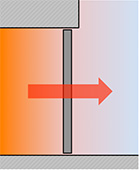
When a door is closed, there is a heat flow that passes through the door. This is defined as the product of its area and the temperature difference between the inside and outside and by what is known as the thermal transmittance of the door or coefficient of heat transmission U.
The thermal transmittance U gives an indication of the level of thermal insulation of the door when closed.
The coefficient U of the door as a whole is determined by the standard EN 12428.
Air Leakage
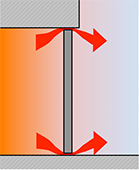
There is a heat flow associated with the exchange of air mass between the inside and outside when the door is closed. It depends on the characteristics of the air (specific heat, density), on the temperature difference between the outside and inside, the area of the door and what is known as air permeability L.
The coefficient L gives us an indication of the level of the leak-tightness of the door when it is closed.
L depends on the pressure difference between the inside and outside which results from the effect of the wind and by the chimney effect in the interior of the building.
Air permeability is defined and calculated by the standards EN 12426 and EN 12427.
Air Infiltration
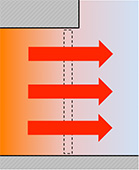
When the door is opened, there is an exchange of air mass of a far greater order than arises due to permeability, although from the physical point of view this is the same phenomenon.
The total amount of energy loss will be determined by how long the door is open.
For a given number of cycles it is the speed of the door which determines the total amount of heat loss due to this effect. We are referring to the average speed in a complete cycle of opening and closing.
During the time that the door is open, the thermal transmittance and air permeability cease to be relevant.
Long Wave Radiation
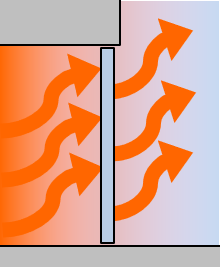
Long wave radiation is the thermal electromagnetic radiation within or surrounding a body in thermodynamic equilibrium with its environment, or emitted by a black body (an opaque and non-reflective body). It has a specific spectrum and intensity that depends on the temperature of the body.
The thermal radiation spontaneously emitted by objects like doors in the form of infrared light can be approximated as black-body radiation.
It also depends on the emissivity of their surfaces. In the label classification calculation, a standard value is considered.
Solar Radiation
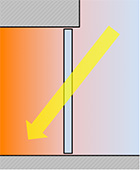
When the leaves or panels of the doors are made wholly or partly of glass or other transparent materials, solar radiation contributes to the heat inside the building. This is an effect which is generally favourable in winter and unfavourable in summer.
The relative amount of the total solar radiant heat energy entering the building through the glass is given by the solar factor or g-value.
In general, the value of the flow of heat by solar radiation depends also on the geographic latitude and the orientation of the elevation. The model takes these factors into account in average terms.
In real building environments, there are other external factors like the presence of shadows due to neighbouring buildings, the existence of parasols or solar protection elements, etc.
Since access doors are at levels close to ground, the influence of the solar factor is lower than for windows or door frames, and in general is of a lower order than other factors, even more so when looking at the effect over the whole year.
Electrical Consumption
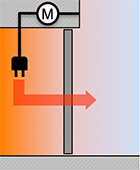
Automatic door actuation consumes electrical energy, primarily in two situations:
In the first case we are talking about power consumption when on stand-by and in the second about power consumed in operation.
Although in general its influence is far lower than other factors, in certain situations it can have a weight of more than 5% in the classification, hence its inclusion in our model.
You can evaluate the relative weight of the different parameters in a very easy way making use of the EDSF Energy Calculator available from E.D.S.F website.
For more details, please refer to the technical documentation that we have made available.
